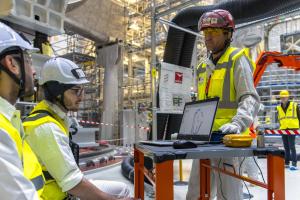Réparation de la chambre à vide : Où en sommes-nous ?
Les opérations sur les secteurs 6 et 7 débuteront plus ou moins en parallèle d'ici fin février/début mars, une fois que l'ensemble des tests et des procédures de qualification seront parachevés. Il s'agira d'abord de meuler les zones défectueuses des interfaces, de réaliser un dépôt de métal qui sera ensuite précisément usiné de manière rétablir les dimensions nominales de chaque zone. L'usinage est une opération assez simple, sans impact sur les propriétés mécaniques, ce qui permettra de minimiser la quantité de métal déposée. Les optimisations sont toujours en cours d'évaluation mais on estime que, pour chacun des secteurs 6 et 7, près de 24 kilos de métal seront nécessaires pour combler les zones creuses des interfaces. Le meulage, le dépôt de métal et l'usinage seront réalisés avec un système de protection local afin d'éviter toute altération de l'environnement contrôlé du Hall d'assemblage. Les secteurs 6 et 7 demeureront positionnés dans les portiques de sous-assemblage géants pendant toute la durée des réparations.
Si le deuxième berceau de basculement n'est pas disponible à temps, la seule solution consistera à transférer le secteur 8 vers le puits d'assemblage pendant que le berceau de basculement existant est modifié pour accueillir le secteur en position retournée. Il s'agirait là d'une opération beaucoup plus lourde et longue, mais ce sera peut-être la seule option disponible.
Les réparations de l'écran thermique progressent elles aussi. Nous ferons le point sur leur avancement dans un prochain article.
Les réparations de l'écran thermique progressent elles aussi. Nous ferons le point sur leur avancement dans un prochain article.





